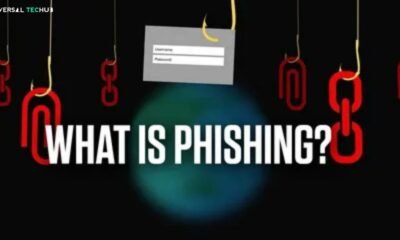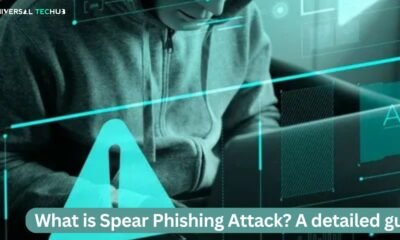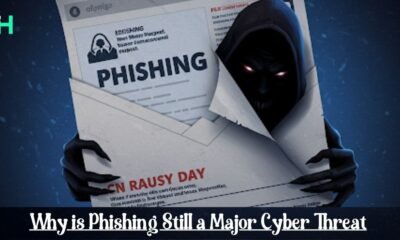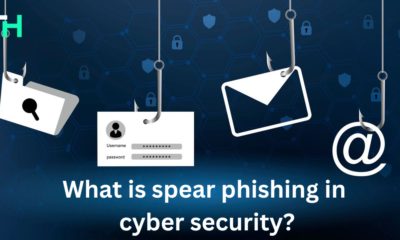Social engineering attack
How do spear phishing attacks differ from standard phishing attacks?

In the current digital environment, where most contact occurs virtually, the risk of phishing assaults, particularly spear phishing, has increased. The unethical practice of sending fake messages that seem to be from a reliable source, usually via email, is known as phishing. However, as hackers have advanced in expertise, they have created spear phishing, a more specialized and customized attack. Understanding how spear phishing attacks differ from standard phishing attacks is essential, as spear phishing focuses on a single person or organization to steal sensitive data or obtain unauthorized access to systems, in contrast to the wide net that phishing casts.
Other types of phishing attacks, such as smishing and phishing using fraudulent URLs, exist in addition to these, each with its strategies and defenses. Furthermore, spear phishing attempts are getting more difficult to identify and stop due to the increasingly advanced tools in these attacks. Therefore, maintaining strong cybersecurity policies requires an awareness of these technologies as well as the strategies used by attackers.
This blog seeks to explore these subjects, offering insightful information on how spear phishing attacks differ from standard phishing attacks, their distinctions, and the instruments employed in these attacks. This investigation goes beyond theory to provide readers with a useful manual for protecting their online selves.
We provide information to help you defeat those exploiting your weaknesses. Come along on this cybersecurity awareness trip with us and learn the difference between spear phishing and phishing to create a strong defense against changing online threats.
What is phishing?
Phishing is a broad cyberattack that targets various instant messaging, social media, and email networks. These attacks frequently use malicious links to direct users to phony websites in an attempt to steal private data, including login credentials or financial information. Sending out thousands of generic messages in the hopes of getting a few bites is a game of numbers.
These texts frequently contain red flags, such as indifferent welcomes, poor language, or frantic requests that pressure you to respond quickly. However, the threat extends beyond emails. Phishing may take many different forms, including voice phishing (also known as phishing), SMS phishing (also known as smishing), and other social engineering techniques.
But what happens if this threat becomes more specific, tailored, and concentrated? Presenting spear phishing, phishing’s craftier cousin.
Understanding Spear Phishing
This technique demonstrates how spear phishing attacks differ from standard phishing attacks by targeting rather than casting a wide net. Armed with information related to the victim’s life or occupation, spear phishing focuses on certain people or organizations. Imagine receiving an email that bears a striking resemblance to a colleague or a pertinent project update. Using your name, position, or recent actions to establish urgency and trust is spear phishing in action.
Behind the scenes, attackers search through public information and social media to create messages that are difficult to ignore. These emails may impersonate a friend or a reliable business, using urgent language and personal touches to fool recipients into clicking on a risky link, downloading a harmful file, or disclosing private information.
In contrast to standard phishing attacks, which broadly target many users with generic messages, spear phishing attacks overcome security measures by using advanced techniques, including email spoofing, dynamic URLs, and zero-day vulnerabilities. To get credentials, they could even use specialized baiting, such as fake HR portal login pages—a tactic that goes beyond the parameters of typical phishing.
Spear Phishing Definition: Targeted Cyberattack Explained
Exploring Standard Phishing Attacks
The number of standard phishing efforts has grown, and they could involve complex operations that target a wide range of people.
Attackers put a lot of effort into obtaining as many people’s credit card information, usernames, and passwords as they can. By creating a sense of urgency, danger, or opportunity, they often attempt to mislead their targets. These attacks aim to deceive the victim by creating fake feelings of opportunity, danger, or urgency.
Phishing attacks often employ emails that deceive recipients into clicking on a phishing link and revealing their login credentials. These communications seem to be from reputable financial organizations or banks. The more emails they send, the more likely they are to deceive someone.
Phishing vs. Spear Phishing: Key Differences
Although spear phishing vs phishing communications both take advantage of human weakness and aim to fool receivers into disclosing private information, they vary in strategy and implementation.
While spear phishing is a targeted attack that may target specific individuals or corporations, phishing is a broad attack that targets a large number of random individuals.
Unlike phishing communications, which are generic and widely applicable, spear phishing emails are carefully customized and frequently incorporate information obtained from social media or other sources to imitate legitimacy.
These spear phishing efforts can be exceptionally difficult to spot and prevent, especially if the spear phishing email is expertly written. While phishing uses generic, impersonal language with a sense of urgency to frighten recipients into taking quick action, spear phishing typically contains contact that seems more genuine and individualized.
What is URL phishing?
The practice of fooling people into accessing dangerous websites by using misleading URLs is known as URL phishing. These URLs frequently seem genuine, yet they take users to an attacker-controlled website. Once on the website, the attacker might trick the user into providing private information, such as credit card numbers or login passwords.
Deceptive URLs employ a number of strategies. Typosquatting is a popular technique where the attacker creates a URL that closely resembles a genuine one but contains a small typo that the user might miss. Using subdomains to give the impression that the URL is from a reliable source is another tactic.
For instance, the URL “www.yourbank.login.com” may seem to be a website on the “login.com” domain, but it is a login page for your bank.
Attention and a solid grasp of URL mechanics are necessary for detecting and fighting URL phishing. Here are some pointers:
- Make sure the URL is correct before clicking on it. Check for errors or other indications that it may not be authentic.
- Avoid clicking on URLs that show up in spammy emails or texts.
- Make use of a web browser that has phishing protection built in. These browsers are frequently able to identify fraudulent URLs and alert you before you visit the website.
- Update your online browser and PC with the most recent security fixes.
- Always use endpoint security, such as ESET Smart Security, which checks all of your outgoing and incoming traffic for dangerous URLs before opening them.
Read more:
What is spear phishing in cyber security?
Steps to Secure Your Business
Learn how to recognize and stop spear phishing attempts, as well as how to differentiate them from regular phishing. Seasoned professionals with in-depth understanding of cybersecurity and regulatory risk for large enterprises have created many courses that offer insightful information. The training covers important subjects like setting secure login credentials and provides examples of spear phishing emails, explaining everything in simple, understandable terms.
Understanding how spear phishing attacks differ from standard phishing attacks is crucial, as spear phishing is more dangerous due to its targeted and customized approach. For protection against prospective attacks, both individuals and companies need to be vigilant and continuously improve their cybersecurity defenses.
By installing robust security measures and offering employee training, you may reduce the likelihood of spear phishing and phishing attacks. It’s also vital to stay informed about the most recent methods that attackers employ. Enroll in the eLearning course “Introduction to Cybersecurity” to start along the path to a safe future.
Spear Phishing Attacks: Real-world Examples
We’ll look at a few real-world examples to highlight how dangerous spear phishing is.
- Between 2013 and 2015, a fake company instructed staff members to transfer almost $100 million into fake accounts as part of a spear phishing campaign against Google and Facebook.
- After warning their bank, Ubiquiti Networks recovered almost $15 million from a spear phishing assault in 2015 that cost them $46.7 million.
- In a 2016 spear phishing attack, attackers posing as the CEO deceived Crelan Bank into moving $75.8 million to a controlled account.
- In 2016, a BEC fraud using the stolen email of their CEO cost Austrian aerospace business FACC €42 million.
These spear phishing examples show how effective spear phishing attacks may result in large financial losses as well as harm to one’s reputation.
See more: What is spear phishing attack? A detailed guide
Final Thoughts
Knowing the subtleties of phishing and its several forms, such as spear phishing, smishing, and URL phishing, is essential in this digital age. Understanding how spear phishing attacks differ from standard phishing attacks is crucial, as these attacks are often more targeted and sophisticated. Because of the always-changing intensity of these attacks and the methods employed, our best protection is constant awareness and learning.
Improving our cybersecurity procedures is essential as we navigate the digital landscape. This involves avoiding spam emails, verifying the authenticity of URLs before clicking, and updating our software and devices with the most recent security updates.
Keep in mind that strength comes from knowledge. We are better prepared for protection against these threats the more we understand them. Remain alert, knowledgeable, and safe.
-

 Phishing attack8 months ago
Phishing attack8 months agoWhat is Spear Phishing and How You Can Identify This Scam?
-

 Social engineering attack10 months ago
Social engineering attack10 months agoBaiting Attacks Explained: A Closer Look at Cyber Threat Tactics
-

 Social engineering attack8 months ago
Social engineering attack8 months agoWhat are Social Engineering Attacks – A Complete Guide to Cyberattacks Prevention
-

 Social engineering attack9 months ago
Social engineering attack9 months agoSpear Phishing Attack: A Targeted Cyber Threat
-

 Social engineering attack10 months ago
Social engineering attack10 months agoWhat is spear phishing attack? A detailed guide
-

 Phishing attack4 months ago
Phishing attack4 months agoWhy is Phishing Still a Major Cyber Threat? Everything You Need to Know
-

 Social engineering attack10 months ago
Social engineering attack10 months agoWhat is spear phishing in cyber security?
-

 Phishing attack8 months ago
Phishing attack8 months agoWhat Are Phishing Emails? A guide for you




















